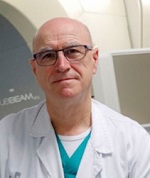GEC-ESTRO ACROP recommendations on calibration and traceability of HE HDR-PDR photon-emitting brachytherapy sources at the hospital level - PDF Version
Jose Perez-Calatayud, Facundo Ballester, Åsa Carlsson Tedgren, Larry A. DeWerd, Panagiotis Papagiannis, Mark J. Rivard, Frank-André Siebert, Javier Vijande.
Radiotherapy and Oncology 176 (2022) 108–117. doi.org/10.1016/j.radonc.2022.09.012
What was your motivation for initiating this study?
The motivation for this work comes from work package 21 (WP-21) within the working group of the Groupe Européen de Curiethérapie-European SocieTy for Radiotherapy and Oncology (GEC-ESTRO) that considers the brachytherapy physics quality assurance system (BRAPHYQS), with a focus on high-energy (HE) high-dose-rate (HDR) or pulsed–dose-rate (PDR) brachytherapy (BT) source calibration.
The aim was to provide European guidance on the calibration of such sources, including practical aspects and issues not specifically accounted for in well-accepted societal recommendations. The report would complement the previously published BRAPHYQS WP-18 report that was dedicated to low-energy BT photon-emitting sources (seeds) (Perez-Calatayud et al., Radiother Oncol. 2019;135:120). Corresponding international societal recommendations pertinent to HE HDR-PDR sources date back more than two decades, and some potential improvements were identified:
- practical considerations including traceability,
- definition of responsibility for source leakage testing,
- the level of agreement between the source strength measured by the user and that reported by the vendor, and
- procedures required when potential discrepancies exceed an action limit.
What were the main challenges during the work?
There were several challenges, amongst which it is worth mentioning the very important collaboration of calibration laboratories and source providers. The fundamental challenges were those listed below:
- To build a list of European metrology laboratories with Ir-192 and Co-60 calibration capacities. The list incorporates information on whether the laboratory is a primary standard dosimetry laboratory or a secondary standard dosimetry laboratory; web links for contact information; and information on the calibration uncertainty.
- To agree on the complex issue of contamination test responsibility. WP-21 decided that it would not provide an all-encompassing recommendation beyond the fact that the responsibility for the official performance and documentation of this test must be clearly established at each hospital. The ideal option should be to reach an agreement with the afterloader company to carry out the test during the installation of the source (for Ir-192) or during preventive maintenance (for Co-60).
- To obtain and understand from the different source providers their source certificates, traceability, and quality assurance programmes.
- To establish an appropriate value for the reference air kerma rate (RAKR) agreement between the manufacturer’s source certificate and the hospital physicist’s assay. To support this task, a survey was performed by WP-21 in a sample of centres in Europe. The survey was the subject of a WP-21 previous publication (Vijande et al., Phys Imaging Radiat Oncol. 2021;19:108).
What are the most important findings of your study?
The most important contribution is the establishment of recommendations, among which the following are highlighted:
- the well chamber’s calibration periodicity can be extended to five years as long as adequate stability control conditions and a very strict redundancy programme are maintained. This recommendation cannot supersede applicable national regulations on this matter;
- the solution of an agreement with the afterloader company to carry out the contamination test during installation of the source (for Ir-192) or during preventive maintenance (for Co-60) which should be proactively pursued at the stage of tendering or contract signing. This solution would be the most logical one, and the entire BT community should work to promote this. If the above solution is not possible, then it remains the responsibility of the hospital physicist, who must have sufficient resources to accomplish this task; and
- a tolerance criterion of 3.0% is recommended for source assays in comparison to RAKR vendor value.
What are the implications of this research?
This report provides a Europe-wide standard in HDR-PDR BT source calibration at the hospital level to maintain high-quality patient treatments.
The WP-21 and BRAPHYQS would like to express their most sincere gratitude for the contribution and/or review of this report to: D. Baltas, R. Behrens, T. Schneider, T. Sander, G. S. Ibbot, L. Persson, G. Holger, M. Andrássy, W. Borneman, Y. Niatsetski, S. Wetherall, G. Schwickert, A. Gutierrez, M. Pinto, M. De Brabandere, and A. Rijnders.

Jose Perez-Calatayud PhD
Radiotherapy Department. Hospital La Fe. Valencia. Spain
Radiotherapy Department. Clinica Benidorm. Alicante. Spain